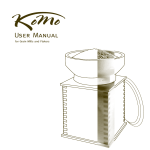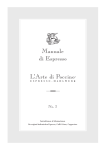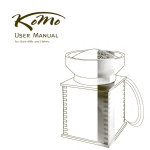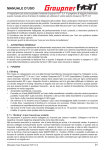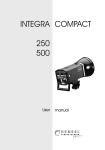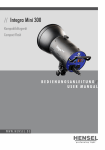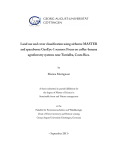Download Service Heft Service Manual
Transcript
Service Heft Service Manual für Foody und Foody Pro Dörrgeräte for Foody and Foody Pro dehydrators DEUTSCH ENGLISH With love for craftsmanship and good cooking Dear Customer, Contents 45 For your Safety ________________________ 46 Foody: Dehydrator Description & Features_ 48 Foody Pro: Dehydrator Description & Congratulations on your purchase of this dehydrator. It is designed with your health and your comfort in mind, and opens up new dimensions for the preservation of all kinds of food. We are confident that the dehydrator and the creations that you conjure up with it will provide you with great enjoyment over the years. Your satisfaction with our appliance is of the utmost importance to us. If you have any questions or comments about the appliance, please get in touch with us via e-mail at: [email protected]. We wish you lots of enjoyment in the preparation of many fine dishes. Features _ _________________________ 50 Care and Maintenance __________________ 52 On Dehydration _______________________ 54 How to Dehydrate______________________ 55 1. Pretreating ______________________ 55 2. Filling the drying trays ____________ 56 3. Drying Times ____________________ 58 4. Drying Temperatures ______________ 58 5. Storing dried foods _______________ 58 6. Reconstruction ___________________ 59 Herbs _________________________________61 Fruit _________________________________ 64 Wolfgang Mock und Peter Koidl Founders and Managing Directors of KoMo Vegetables ____________________________ 68 Meats and Fish _________________________71 Technical Specifications_ ________________ 74 Troubleshooting Guide __________________ 75 Accessories ___________________________ 76 Warranty and Contact___________________ 78 Imprint_ ______________________________ 80 ENGLISH More than 25 Years of Experience Important Safeguards When using electrical appliances, basic safety precautions should always be followed, including the following. Read all instructions! Do not touch hot surfaces. To protect against electrical hazards, do not immerse cord, plugs, or the base of the dehydrator in water or other liquid. Use close supervision when any appliance is used by or near children. Unplug from outlet when not in use and before cleaning. Do not operate any appliance with a damaged cord or plug. If the appliance malfunctions or if it has been damaged in any manner, return the appliance to an authorized service facility for examination, repair and/or adjustment. The use of accessory attachments not recommended by the manufacturer may cause hazards. Do not use outdoors. Do not let cord hang over edge of table or counter or touch hot surfaces. Do not use appliance for other than intended household use. Do not place dehydrator on a towel or carpet as this will restrict the dehydrators airflow and could result in damage to the appliance. Always leave at least 3 cm of space around the dehydrator for proper ventilation. The appliance has a short power cord to reduce the hazards resulting from becoming entangled in or tripping over a longer cord. An extension cord may be used if care is exercised during its use. Use a heavy extension cord (5 amp rating or higher). If using a longer cord, arrange so it will not drape over the counter or tabletop. Do not expose dehydrator to temperatures above 80 °C. Do not wash in dishwasher. This appliance has a polarized plug. One blade is wider than the other. As a safety feature this plug will fit in a polarized outlet only one way. If the plug does not fit fully in the outlet, reverse the plug. If it still does not fit, contact a qualified electrician. Do not attempt to defeat this safety feature. Save these instructions. Household use only. Do not place on or near a hot gas or electric burner, or in a heated oven. Turn appliance off first, then remove plug from outlet. 47 ENGLISH For your Safety 46 Foody Trays Includes 6 trays of safe, stable BPA Free ABS plastic. 1 Lid Mesh Tray Inserts Includes 6 inserts of safe, stable BPA Free ABS plastic. Prevents small or diced pieces of fruits and vegetables from falling through holes in the dehydrator trays. Trays Base 5 On / Off Switch 4 Temperature Control Knob Fruit Leather Sheets Includes 2 free sheets of safe, stable BPA Free ABS plastic. These sheets fit directly into the trays and are designed to prevent the fruit puree from spilling. 49 4 Temperature Micro-processor controlled heat sensor stabilizes the drying environment. Solid-state variable temperature control ensures precise results. 5 On / Off Switch solid flip switch for easy operation Additional trays, inserts and sheets are available as an accessory from your local dealer. ENGLISH Foody: Dehydrator Description & Features 48 Foody Pro Trays Includes 6 trays of safe, stable BPA Free ABS plastic. 1 Lid Mesh Tray Inserts Includes 6 inserts of safe, stable BPA Free ABS plastic. Prevents small or diced pieces of fruits and vegetables from falling through holes in the dehydrator trays. Trays Fruit Leather Sheets Includes 2 free sheets of safe, stable BPA Free ABS plastic. These sheets fit directly into the trays and are designed to prevent the fruit puree from spilling. Yogurt Cups Includes 4 cups of safe, stable BPA Free ABS plastic. These cups fit directly into the deep trays and allow you to make fresh yogurt. Filter Includes 2 filters. Filters the air so all your dehydrated food is free from impurities. Base 5 On / Off Switch 4 6 Temperature Control Knob Time Control Knob 4 Temperature Micro-processor controlled heat sensor stabilizes the drying environment. Solid-state variable temperature control ensures precise results. 5 On / Off Switch solid flip switch for easy operation 6 Timer The Foody has an automatic timer shutoff (up to 99 hours). Additional trays, inserts and sheets are available as an accessory from your local dealer. ENGLISH Foody Pro: Dehydrator Description & Features 51 50 Getting Started Before using your dehydrator for the first time, wash the trays, top cover, mesh inserts and fruit leather sheets in warm, soapy water. 7 Consult various tables to determine what temperature/time is neccessary. 8 Plug power cord into any standard household outlet. Quick Guide 9 You are now ready to dehydrate. 1 Place dehydrator base on a flat, (not carpeted), dry and stable surface. Care and Maintenance 2 Be sure the filter is clean and in place. 3 Prepare foods and fill drying trays. Do not cover center hole in trays! 4 Stack trays on base and place top cover on dehydrator. 5 Make sure drying trays are securely aligned on top of each other. 6 Make sure there is at least one inch of clearance around dehydrator to ensure proper airflow. After Each Use Clean the trays, top cover, mesh inserts and fruit leather sheets, (if used), with warm, soapy water. Soaking and /or using a plastic scrubber may remove stubborn particles. Warning Do not put trays, mesh inserts, fruit leather sheets or top cover in the dishwasher. Heat from most dishwashers, (on drying cycle), can cause them to warp. Do not use abrasive scrubbers, cleaners or solvents to clean plastic. These will scratch the surfaces of the appliance. Do not submerge the power unit / base in water. Wipe with a clean cloth. Service If your dehydrator experiences a problem, first refer to the Troubleshooting Guide on the following page. For service or warranty see Warranty and Service information at page 78 and 79 of this manual. 53 ENGLISH Care and Maintenance 52 Benefits of dehydrating food – what is dehydration? On Dehydration Dehydrated foods should be stored in an airtight container. Dehydration refers to a process in which moisture is removed from food, preventing spoilage, and allowing dried food to be stored safely for later use. Few nutrients are lost during dehydration. How to dehydrate Benefits of dehydrating food The food retains almost all of its nutrients and taste. You can control the quality of your food; preserving food at its nutritional peak. The weight and size of food is reduced. There are no worries about spoilage, unlike frozen foods, if there is a loss of electricity. Food becomes more energy-dense. Food is not subjected to extreme high temperatures as in the canning process. Preparation is easy and the drying process doesn’t need to be constantly attended. Dehydrating can be done overnight. Dehydrated foods are easy to store and simple to use. Storing dehydrated foods is energy efficient. Dehydration concentrates natural flavor, sweetness and aroma of food. Equipment Sharp paring knife (Use stainless steel blades. Carbon blades may turn some fruits and vegetables dark. A vegetable slicer or electronic slicer may also be useful.) Cutting board Blender (for making leathers and powders) Storage containers Optional: Peeler, steamer and basket, or kettle and collapsible steamer Since natural sugars concentrate as you remove moisture, the dried product is naturally sweet. Usually, you won’t need to add sugar because of this natural sweetness. Decide Then Dehydrate Before beginning, decide how dehydrated food will be used. For example: snacks, baked goods, soups, sauces or dips. This will help The only way to become an expert is through experience. Experiment with various drying times and temperatures. Record what works best for you. Before dehydrating, wash hands thoroughly. Make sure the counter, cutting board, utensils, equipment and storage containers are clean prior to using. Selecting Food Pick the best quality food at the peak of ripeness and flavor. Cut away any bruised or damaged sections. How to Dehydrate determine how thick to slice food, whether to peel or not and whether to salt or season. To Peel or Not Peels tend to be tough when dried and take longer to dry; however, the peels of fruits and vegetables often contain much of the food’s nutritional value. Peeling is a personal preference. If you would normally peel the food for a specific recipe, plan to peel the food to be dehydrated. Peel apples intended for pies or tomatoes intended for soup. It is better not to peel, if the dried food is to be eaten as a snack. Cutting Makes a Difference Slice or cut food to uniform thickness. This allows even drying. Don’t slice food too thin. 1/4 is preferred for most fruits and vegetables. Moisture rich foods such as watermelon, may need to be sliced thicker to dehydrate properly. Moisture escapes best from a cut or broken surface, not through tough skin. The larger the cut area, the faster and better the food dehydrates. Thin stalked vegetables like green beans, asparagus or rhubarb should be cut in half lengthwise, or with an extreme diagonal cut. Broccoli stems should be halved or quartered, depending upon diameter. Fruit should be sliced across the core. Make thin, flat cuts. Small fruits like strawberries can be cut in half. Smaller berries should either be cut in half or blanched slightly to break the skin. 55 1. Pretreating Dipping in a Pretreating Solution (generally used for fruits) Some fruits, such as apples, pears, peaches, apricots and bananas tend to oxidize and darken somewhat during drying or when stored beyond 6 – 7 months. To prevent discoloration and extend shelf life, pretreat as follows: 1 Dipping Solution: We prefer using bottled lemon juice, 2 parts juice to 1 part water. You may also use orange juice, pineapple juice, (fresh or bottled), fresh lemon juice, ascorbic acid or a produce protector such as Fruit-Fresh. Ascorbic acid may be purchased from drug stores. Mix 1 tsp ascorbic acid per quart of water. Follow label directions for Fruit-Fresh. 2 Allow fruit to sit in pretreating solution for 2 – 5 minutes. Do not leave fruit in the solution for longer than 10 minutes. 3 Strain through fine mesh strainer before placing on drying trays. Blanching / Steaming Benefits (generally used for vegetables) Sets color Stops ripening process (enzymatic action) ENGLISH 54 Prevents changes in flavor Facilitates the drying process and reduces drying time Reduces contamination from molds and bacterial growth Note Many vegetables such as beans, corn, peas and broccoli must be steamed or blanched before drying. Carrots and celery should be blanched or steamed. Although untreated vegetables used within three to four months will have acceptable flavor, heat treated vegetables will have better color and reconstitute much more quickly. A few vegetables, such as onions, garlic, peppers, tomatoes and mushrooms can be dried and reconstituted successfully without heat treatment. Generally, if vegetables must be steamed or blanched for freezing, they must be treated for drying. Blanching is faster than steaming. How to Blanch 1 Place vegetables in a basket or colander. 2 Dip filled basket or colander into a pot of boiling water for 5 – 20 seconds depending upon size of cut vegetable. (Leave in water only until you notice a change in color). 3 Remove immediately. Dip in ice cold water to stop cooking process. 4 Drain and place on drying trays. How to Steam 1 Place vegetables in a basket or colander that will allow steam to circulate around the vegetables. 2 Dip filled basket or colander into a pot with about 5 cm of boiling water. Food should not make contact with water. 3 Cover and steam 3 – 5 minutes. 4 Remove immediately. Dip in ice cold water to stop cooking process. 5 Drain and place on drying trays. 2. Filling the drying trays Before filling the trays Be sure to blot all excess moisture from foods that have been washed, sugared, marinated or are high in moisture, (such as very ripe tomatoes or citrus fruit) to prevent dripping. Filling the trays 1 Once the food has been properly sliced (and pretreated, if desired), begin filling the dehydrating trays. 2 Arrange food on the tray in a single layer. Leaving a little space between each piece of food. 3 Make sure the center hole in each tray is always left uncovered to allow air to circulate. 4 If only one side of the food is cut, place the cut side up. Filled Trays 1 Do not immediately place filled trays onto the dehydrator base. 2 Let excess moisture drip off the trays before putting on the base by either tapping each tray firmly on a towel to remove excess moisture or let filled trays sit away from the dehydrator for 10 minutes, on a towel or paper towels. 3 Placing trays on a towel or paper towels to collect moisture will make cleanup easier. 57 Note Always fill the trays with food before placing trays onto the base. Caution: If loose particles get into the base or moisture drips down to the base and gets into the motor, it will damage the motor and electronics. To prevent any damage make sure you follow the instructions below carefully. Optional 1 To catch any remaining overflow that may occur, use fruit leather sheets placed on the bottom two trays. 2 Alternate placing the sheets on one half of each tray. This will allow the warm air to circulate. 3 Place these two bottom trays (without food), directly on the dehydrator base. 4 Do not use wax paper, as the wax will melt at dehydration temperatures. Remember to always leave the center hole uncovered or unobstructed. Fruit leather sheets and empty trays may be removed when food stops dripping. ENGLISH How to Dehydrate 56 How to Dehydrate 3. Drying Times It is impossible to give exact drying times because the moisture content of each food varies with the weather, soil conditions, where it was grown, how thick it was sliced as well as the particular variety of food. Denser food takes longer to dry. With a little experience, you’ll be able to tell which foods take the longest. For example tomatoes, which are normally quite juicy, will take longer than cabbage, which is dry. Citrus fruits will take longer than apples. Record your successes for future reference. Begin to check sliced fruits, vegetables and meats periodically after several hours of drying time. Check more often near the end of the drying process. Herbs, leathers or chopped and shredded foods may dry sooner. If foods have been over dried and seem brittle or slightly browned, they are still usable for soups or most baked goods. They may take slightly longer to reconstitute and require additional water, but flavor is generally not impaired. 4. Drying Temperatures Temperature settings can vary, there are no absolutes and quite a few variables in drying food. The only way to become proficient is to dry, dry, and dry some more. Certain varieties of produce and humidity in the air make a difference in the drying time and quality of dried products. Experiment with different drying temperatures, thicknesses of produce, and pre-treatment vs. no pre-treatment. The following are good starting points when drying different types of foods: (temperatures in Celsius): Fruits: 50° to 60° Vegetables: 50° to 60° Jerky: Start at highest setting (70°), after 4 hours, turn down to 60° – 65° and dry until desired texture is reached. Herbs: 35° to 37° Nuts: 32° Yogurt: 45° (Foody Pro) Note Tray rotation: The KoMo Dehydrator is designed to operate with up to 20 trays. When using more than 4 trays, periodic rotation will give optimum results. Inspect drying trays periodically. Rotate trays if food being dried requires it. Place top tray on the bottom, followed by the next uppermost tray, etc. 5. Storing dried foods When food is sufficiently dehydrated, thoroughly cool before storing (approximately 15 – 30 minutes). If food is allowed to sit too long in the open air, it will begin to absorb moisture. Select appropriate airtight storage containers and store at optimal conditions. If moisture or condensation appears in storage container, food has not completely dried. Return to dryer and continue to dehydrate until completely dry. Containers Any container that is clean, airtight, and moisture-proof is suitable for storage. Fill each container as much as possible. Heavy, zippered plastic bags or heat sealing bags make excellent choices. Filled bags may be placed in metal cans with lids (shortening or coffee cans are good). This will keep out insects and light. Glass jars with tight-fitting lids can be used with or without plastic bags. Plastic containers with lids are good, but should be used in conjunction with locking plastic bags, because plastic containers are not airtight. Do not use paper or cloth bags, lightweight plastic bags, bread wrappers, unlined metal containers or any container without a tight-fitting lid. Labeling Label dehydrated food with the name of the product, date dried, and quantity/ weight. This helps in rotating food and minimizes waste. Location Cool, dark and dry are the keys to maintaining the quality of dried food. Glass jars or plastic containers should be placed in a paper bag or in a closed cabinet to keep out light. Cement walls and floors are often damp. Dried food containers should not be placed directly on the 59 floor, or touching a basement or cellar wall. Do not store dried food near items with a strong odor, such as varnish, paint remover or kerosene. Length of Storage In most cases, dried fruits and vegetables should not be stored longer than one year. Plan to use all dried meats, fish, poultry or jerky within a month or two. Rotate on a first-dried, first-to-be-used basis. Check dried foods periodically. If the food seems more moist than when packed, moisture may be getting into the container. Spread food on drying trays and dry again. Then pack the food in an airtight container. Mold indicates that food was not properly dried the first time, or was not properly stored. Discard or compost moldy food. Do not try to use it. 6. Reconstruction Reconstitution refers to putting moisture back into food. You will often want to reconstitute dried foods before adding to recipes, using as side dishes or combining with other ingredients. When allowed to soak in liquid, dried food will swell to its original shape and size. Place food in a container with enough water or liquid to cover. Then soak until it is at desired consistency. Refrigerate while soaking to prevent spoilage. Do not add seasonings during this process. ENGLISH 58 You may use liquids other than water, including juices, consommé, milk, etc. Try not to use more liquid than necessary for reconstitution, as nutrients will be drained away with the excess. There is no need to reconstitute ahead of time when making soups. Dried vegetables can be added directly to the soup about one hour before serving. For chopped or shredded vegetables and fruits to be used in cookies, no reconstitution is usually needed. If the pieces are crisp and dry, sprinkle with 1 Tbsp. water per 1 /2 cup of dried food. For vegetables and fruits to be used in soufflés, pies, quick breads, doughs or batters, use 2 parts water to 3 parts (by volume) dried food. For vegetables and fruits which will be cooked in liquid, such as vegetable side dishes, fruit toppings, and compotes, use 1 to 1 1 /2 parts water to 1 part dried food. Extra liquid may be required for proper cooking. Chopped and shredded foods reconstitute quickly. Generally, 15 to 30 minutes is sufficient. Whole pieces or slices of fruit or vegetables and meat cubes take longest to reconstitute and are best left to soak in the refrigerator overnight. Some foods take longer to reconstitute than others. Carrots and beans require more time than green peas or potatoes. A rule of thumb: those that take the longest to dehydrate will take the longest to reconstitute. If food cannot be soaked as long as necessary, place in boiling water, remove from stove, and let stand 2 to 3 hours. How to Dehydrate Rehydrating meat is usually completed in 1 to 4 hours by soaking in an equal amount of water (in the refrigerator), or by gently simmering in water. Use only enough water to cover meat. If you drain reconstituted foods, save the liquid. This liquid has great nutritional value. Freeze for use in soups, leathers, pies or compotes. Do not add spices, salt, bouillon cubes or tomato products until vegetables are reconstituted and cooked. These items may hinder rehydration. Herbs Dried herbs are much more flavorful than fresh herbs. Some guidelines: 1 tsp dried herbs = 1 Tbsp fresh herbs 1 / 4 tsp dried ginger = 1 tsp fresh grated ginger 1 tsp onion powder = 1 medium onion 1 / 8 tsp dried garlic = 1 clove garlic Many herbs can be harvested through the entire growing season. Two-thirds of the plant may be cut, leaving the rest to grow. Once plants are cut, regular cuttings will prevent them from flowering. Flowers, seeds, leaves and stems can all be used for seasoning. If flowers are used in teas, dry them whole. Remove any tough or discolored parts. Dried herbs have an excellent shelf life. If stored under normal storage conditions, they will keep their potency for four years or more. Dark colored containers are best for storage. Light fades color and weakens flavors. Preparation 1 Select herbs just before the plant blooms. Leaves should be fully developed, yet tender. 2 Flowers should be harvested when they first open and are still very fresh. 61 3 Harvest on a sunny morning after the dew has evaporated. 4 Herbs require no pretreatment. 5 Wash leaves and stems lightly in cold water. Spread on absorbent towel, shake off any visible moisture or pat dry. 6 Be sure to remove any brown spots and insect debris from the leaves. 7 Strip leaves from larger stems. Dry parsley or sage on the stems. 8 Entire pods or seeds of chili peppers can be dried. 9 Herbs can be placed on the drying trays within minutes of picking and cleaning. 10 Use either mesh insert trays or fruit leather sheets. 11 Herbs will be brittle and crumble easily when dried. Some leaves will darken in color but that does not affect flavor. ENGLISH 60 Herbs 12 After drying, leaves can be stripped from the stem and left whole, ground in a coffee grinder or crushed. To crush, rub between fingers, use mortar and pestle or press through a fine screen. Suggested uses for dehydrated herbs Use in Italian, Mexican and Chinese dishes. Also use in soups, stews, sauces, vegetables, salads, cakes, cookies, meat dishes, fish dishes, egg dishes and in seasoning mixes. 13 Store in airtight containers in a cool, dark, dry place. If moisture appears on the inside of the container, the herbs will need further drying. Note Dry herbs at 35 – 40 °C. Use average times only as a general guideline. Many variables can contribute to a large difference in drying times. Check herbs periodically to ensure correct drying results. 14 Dried herbs can be difficult to distinguish, so storage containers should be labeled immediately following drying. Here you can make your own notes as you gain experience in using the dehydrator: 63 Herb Part of plant to dehydrate Dry Time (Hrs) * Basil Leaves 1 – 3 Chili Peppers Pods 5 – 12 Chives Leaves (Chop) 2 – 3 Cilantro Leaves 1 – 3 Cumin Seeds 2 – 5 Dill Leaves 13 Fennel Leaves Seeds 1 – 3 2 – 5 Garlic Cloves (Break bulbs into cloves. Remove outer peel of each clove.) 35 Ginger Root and leaves 13 Mint Leaves 13 Oregano Leaves 13 Parsley Leaves and stems 13 Rosemary Leaves 13 Sage Leaves and stems 13 Tarragon Leaves 13 Thyme Leaves 13 * Average Dry Time ENGLISH 62 Dried fruit has no preservatives, is nutritious, and has a naturally sweet taste. Suggested uses: snacks, cookies, pies, cobblers, cakes, breads, ice creams, pancakes, jams, fruit leather, sweetener for waffles or cereals and more. 6 Cut fruit into slices, pieces or halves. Uniform 1/2 cm slices are best for most. Process 1 Select firm, ripe fruit (not overly ripe), free of bruises and blemishes. Sort through grapes and berries. Remove those with imperfections. 8 Use mesh inserts for any small fruits or pieces that might fall through the holes in the dehydrator trays. 2 Wash fruit that is to be dehydrated with the skin. 3 Peel fruits, if desired or necessary. For easy peeling of fruits such as peaches, dip in boiling water until skin cracks. 4 Waxy skinned fruits like cherries, cranberries, grapes (raisins), and blueberries that will be left whole must have their skins poked or be placed in boiling water for 1 – 2 minutes to remove waxy coating. 5 Berries may be blanched or steamed to pop their skins which will shorten the dehydration time. Cut, remove stems, stones, pits, cores and seeds. Cutting uniform slices will allow food to dry evenly. 7 See Page 55 (Pretreating) for fruits that may turn dark during the drying process. 9 Place fruit evenly on trays. If using more than 4 trays rotate once during drying time. Tutti-Fruit Dissolve flavored gelatin according to directions on package. Soak apple or pear slices in mixture for 10 minutes. Blot dry on paper towels. Dehydrate. Variables can contribute to a large difference in drying times. To test for dryness: remove a piece of fruit. Let it cool. Cut or tear. Fruit should have almost no moisture. Most fruits will still be pliable and leathery. Bananas and strawberries should be almost crisp. You can leave softer, if you do not plan on storing for a long time. Store dehydrated fruit in an airtight container. Note Dry fruit at 55 – 60 °C. Use average times only as a general guidelineFruit Leather Fruit Leather Pureed fruit dried in thin sheets becomes a tasty, candy-like fruit leather snack. 1 Pit, then puree fruit of your choice, adding just enough liquid (fruit juice or water) for the blender to puree effectively. Often no liquid is needed. 65 fruit leather sheets on alternate halves of the trays in the stack. 7 After all fruit leather sheets are filled, stack the drying trays on the base. 8 Set temperature to 60 °C. Dehydrate about 8 – 11 hours. 2 Fruit may also be mixed with applesauce. One cup applesauce will prevent leather from cracking or splitting. 9 Rotate fruit leather sheets, (not dehydrator trays), twice during drying time, (about every 3 hours). 3 If fruit is tart, you may also add a sweetener. 10 Leather is done when you notice puree to have a leather texture with no sticky spots. It should easily remove from the fruit leather sheet. 4 Lightly spray fruit leather sheets with vegetable oil before pouring on puree to prevent sticking when removing leather. You can also use a little olive oil. Rub it on a fruit leather sheet with a paper towel. 5 Place fruit leather sheet(s) into dehydrator tray(s). Pour one cup of fruit puree onto a sheet. Remember to leave the drying tray’s center hole uncovered. 6 For adequate circulation, only one half of the dehydrator drying tray should be used. Place 11 Wrap in plastic wrap and store at room temperature or refrigerate. 12 Spices, chopped nuts or coconut may be added to the puree for extra flavor. For further variation, puree several types of fruit together. Don’t be afraid to experiment! Vary the amounts according to availability, taste and imagination. If the puree tastes good, the leather will be better. Remember the flavors, and sweetness, concentrate with drying. ENGLISH Fruit 64 Fruit Note Try the following combinations Apples, oranges, bananas and sunflower seeds Cooked cranberries, oranges and honey Raspberries, bananas and coconut Fruit Preparation Drying Time / Hrs * Coconut Remove outer skin. Slice. 12 – 16 Cranberries Wash. Remove stems. Place in boiling water for 1 – 2 min. Blot dry. 14 – 22 Grapes Cut in half. Remove seeds. Place cut side up. Seedless green are better than red or black. Poke skin or place in boiling water 1 – 2 min. Blot dry. 13 – 36 Test for Dryness Kiwi Peel. Cut into slices. Slice 0,6 – 1 cm thick. 13 – 17 Leathery, no moisture when cut Mangos Remove skin and slice. 10 – 18 Melons Remove skin and seeds. Use deepest tray for watermelon. Cut in slices as thick as deep tray size will allow. 12 – 16 Peaches Peel, if desired. For easy peeling, dip in boiling water until skin cracks. Cut in half. Pit. Cut in slices. 6 – 16 Leathery, may be slightly sticky in center Pears Wash. Peel if desired. Core. Cut in slices or rings. 6 – 16 Leathery, no moisture when cut Pineapple Remove crown, skin & eyes. Cut in half. Cut in slices, leaving core in or remove, dice or chop and use Mesh Inserts. 6 – 12 Pliable, still slightly sticky. No visible signs of moisture Plums Do not peel. Cut in half. Pit. Turn inside out or cut in slices. 8 – 16 Leathery, pliable Rhubarb Trim. Wash. Slice diagonally into 2 cm pieces. Steam 3 – 4 min. Use Mesh Inserts. 6 – 14 Brittle Strawberries Wash. Cut in half. Place cut side up. 6 – 12 Hard, brittle Strawberries and bananas Strawberries and rhubarb Pineapple and peaches Raspberries and apples Apricots and plums Drying Time / Hrs * 67 Fruit Preparation Apples Peel if desired. Core. Cut slices, rings or chop into pieces. 4 – 10 Apricots Do not peel. Halve and pit. Turn inside out or cut slices. 8 – 16 Leathery, pliable Bananas Peel. Cut into slices 1 /4 – 1 /2 cm. 6 – 12 Leathery, slightly sticky in the center, brittle Firm Skin Berries (Blueberries, etc) Sort. Poke skin or place in boiling water for 1 – 2 min. Blot dry. 10 – 18 Hard Berries Leave whole. 10 – 18 Hard Cantaloupe Cut in half. Remove seeds and peel. Cut slices. Blot dry on paper towel. 8 – 20 Leathery, suede-like Cherries Wash, pit and remove stems. Poke skin or place in boiling water for 1 – 2 min. Blot dry. 20 – 26 Citrus Fruit Peel, if desired. Cut into slices. 6 – 12 Hard Test for Dryness Raisin-like texture * Average Dry Time ENGLISH 66 Vegetables Dried vegetables are very versatile. Use them to make soups, stews, soufflés, casseroles, and dips. They can also be used in recipes calling for fresh or canned vegetables. 7 Dry vegetables until there is no visible sign of moisture and they are brittle, hard, or crisp. Peas should shatter when hit with a knife. Preparation 1 Select fresh, firm, ripe vegetables that are free from blemishes. Tender green beans, corn and peas are preferred. Celery, carrots and peppers should be crisp. Dry as soon as possible after picking to retain the most nutrients. 8 If using more than 4 trays, rotate once or twice during drying time. 2 Wash vegetables thoroughly in cold water before processing. 3 Trim, core, peel, slice or shred vegetables. 4 If cutting vegetables into slices make sure they are a uniform size. 0,6 – 1,2 cm are best for drying. 5 See Page 55 (Pretreating) for information about vegetables that need to be steamed/blanched before dehydrating. Some vegetables require no pretreatment. Blanching decreases drying time. 6 Spread vegetables in a single layer, unless shredded or grated. Vegetable Powders Vegetables may be pureed, dried as leathers, and then powdered for making juices, soup bases, dips, salad dressings, or baby foods. Dehydrate vegetable leather until very brittle. Immediately powder small amounts in a dry blender or coffee grinder. Brittle, sliced or chopped vegetables can also be powdered. Powders must be stored in airtight containers to avoid clumping. For example reconstitute powdered tomatoes with water until they are the consistency you desire. Adding a small amount of water makes a great tomato paste, adding more water makes a great tomato or pizza sauce. Remember powders have very concentrated flavor. Vegetable Chips Vegetable chips offer a great crunchy texture and taste. Select vegetables such as cucumbers, eggplants, zucchini, or parsnips. There is no need to peel. Cut very thin slices (0,3 cm thick). Steam 3 or 4 minutes, if chips will be stored longer than 5 months. Sprinkle generously with salt before drying. (Seasoned salts make an interesting chip). Dry until very brittle. These can be served plain or with dips. 69 Note Dry vegetables at 50 – 58 °C. Use average times only as a general guideline. Many variables can contribute to a large difference in drying times. Vegetables should contain only 5 % moisture and should look and feel crisp and brittle. Vegetable Preparation Dry Time (Hrs) Asparagus Remove woody end. Slice diagonally into 1,2 – 2,5 cm pieces. Blanch/steam. 3 – 10 Green Beans Snip off ends, pull off strings. Dry whole or slice diagonally into 1,2 – 2,5 cm pieces or cut lengthwise. Blanch/steam. 6 – 12 Beets Steam until tender. Cool and peel. Cut in slices, cubes or shoestring strips. 3 – 10 Broccoli Cut all stalks in halves or quarters. Blanch/steam. 4 – 10 Cabbage Trim outer leaves. Cut in half. Core. Cut into strips or dry whole leaves. Blanch / steam. 4 – 10 Carrots Remove tops and stringy end. Peel, cut crosswise, lengthwise or diagonally into slices, cubes or grate. Blanch / steam. 4 – 12 Cauliflower Cut off woody base. Separate into small flowerets, slice or cube into pieces. Blanch / steam. 6 – 14 Celery Trim. Cut lengthwise or crosswise into strips or pieces. Leaves may also be dried. Blanch / steam. 3 – 10 Corn Remove husk and silk. Blanch / steam. Plunge immediately into cold water. When cool, drain. Cut kernels from cob. 6 – 12 * Average Dry Time ENGLISH 68 Vegetable Preparation Dry Time (Hrs) Cucumbers Peel (skin is bitter when dried). Slice or shred. Salt, if desired. 4 – 10 Eggplants Trim. Peel. Cut into round slices, julienne strips or cubes. Blanch / steam. Skin may be dried separately. 4 – 14 Greens Cut off stems. Blot dry on paper towels. 4 – 10 Mushrooms Remove woody stems. Wipe with brush or cloth. Do not wash. Slice or cube. Small mushrooms may be dried whole. 4 – 10 Okra Trim off stem and tip. Slice pods into pieces or cut lengthwise. 4 – 10 Onions Cut off stem and root. Remove outer skin cut in slices, rings or dice. 6 – 12 Peas Sort. Blanch / steam. 5 – 14 Peppers Remove stem and seed head. Cut in rings, strips or dice. Seeds may also be dried. Blanch / steam. For seeds use leather sheets. 5 – 12 Potatoes Peel. Remove green lining just under skin. Cut away bruises. Cut into slices, strips or grate. Blanch / steam. 4 – 12 Pumpkins Cut in half. Scrape away pulp and seeds. Remove rind. Cut into wedges 2,5 – 7,5 cm wide and then into strips 1,2 cm wide. Seeds can also be dried. Blanch/steam. 6 – 12 Winter Squash Cut in half. Remove seeds and stringy fiber. Peel off rind. Cut into strips or cubes. Seeds may also be dried. Blanch /steam. 4 – 10 Summer Squash Cut in half. Remove seeds and stringy fiber. Peel off rind. Cut into strips or cubes. Seeds may also be dried. Blanch/steam. 4 – 10 Tomatoes Remove stem area. Peel, if desired. Cut in slices. Blot excess moisture before drying. 6 – 12 * Average Dry Time Meats and Fish The KoMo Dehydrator can make dried meat and jerky. Dried meat refers to meat, poultry, or fish that has been cooked then dried. Jerky is raw meat or fish that has been seasoned and dried. Dried meats are best when made for upcoming camping and backpacking trips. When reconstituted, they yield a tasty meat, somewhat like fresh cooked. Practically any meat can be dried, but fatty meats are not recommended. Suggested uses Snacks, soups, stews, casseroles, pizza toppings or rehydrate and use in salads. Guidelines Choose lean cuts of meat. The leaner the meat, the better quality of the dried product. Chicken breasts are leaner than dark meat. Cleanliness is critical when working with raw meats. Make sure all surfaces, utensils and your hands, are washed thoroughly. Except for jerky, all meats, fish and poultry should be cooked before being dried. Braising, pot roasting or steaming are best, because no fat is used with these cooking methods. Never dehydrate raw chicken or poultry because it could contain salmonella. Cut meats across the grain into thin strips about 2,5 cm wide and 0,5 cm thick. Trim off all fat and connective tissues. For easier cutting, partially freeze by placing meats on the bottom of the freezer for about 30 minutes. Turn and freeze 15 minutes longer. To prepare fish, filet, then cut into 2,5 cm strips. 71 Do not store dried meat, fish, or poultry longer than two months. Store dried meat in an airtight container, a sealed plastic bag, or jar with an airtight lid. Keep in the refrigerator or freezer. Note Meats, poultry, and fish generally take 6 – 12 hours to dry. This is a general guideline. Drying times may vary. Dehydrated meats, poultry and fish darken in color when dried. Dehydrate until pieces are dry but will bend without breaking, with no evidence of moisture. Jerky Jerky is the only meat to be placed uncooked in the dehydrator. Your KoMo Expandable Dehydrator quickly turns thin strips of seasoned meat or ground beef strips into a hearty snack. It is recommended that pork not be dried for jerky, as the drying temperature is not high enough to kill harmful bacteria. Note Start Jerky at 70 °C (highest setting). After 4 hours decrease temperature to 60 – 62 °C. Dry until desired texture is reached. Jerky generally takes 6 – 10 hours to dry. This is a general guideline. Drying times may vary. Dehydrate until strips are dry, but can be bent without breaking. Jerky should be tough (slightly chewy), not brittle, with no evidence of moisture. ENGLISH Vegetables 70 Meats and Fish Preparing Jerky It is essential when working with raw meats to keep working conditions clean. Wash hands thoroughly each time you touch another item. Make sure all surfaces and utensils are washed completely. To prepare ground beef: Always use the leanest ground beef. You will need a jerky gun accessory to shape the ground beef into strips. To prepare fish: filet, then cut into 2,5 cm strips. To prepare meat: Select lean meats, (lean flank or round steak makes great jerky). Trim off all fat and connective tissue. Cut into strips about 2,5 – 4 cm thick. Note For easier cutting, place meat in the freezer for about 30 minutes to partially freeze. Turn over and freeze 15 more minutes. Cut across the grain into strips about 0,3 cm thick. Seasoning Jerky 1 Season or marinate meat or fish from 1 / 2 hour to overnight in the refrigerator. Increase the marinating time for a stronger flavored jerky. A simple salt solution marinade improves flavor while reducing the potential of spoilage. Most barbecue marinades may be used, as long as they contain no oil. Adding lemon juice to the marinade will help preserve redness. Vinegar added to a marinade will soften the wild taste of game meats. 2 Meat may also be seasoned with salt, pepper, garlic, onion powder, or other spices instead of marinating. Because flavors intensify during dehydration, use salt sparingly. However, season meat dried for jerky a little heavier than for regular cooking. 3 Discard unused marinade that has been mixed with meat. Note Doing ground beef jerky is slightly different than other meat jerkys. Use the leanest ground beef possible. Instead of a marinade or a dry rub use a Jerky Spice mixture that includes a cure. Mix this in with the ground beef. Allow time for the ground beef and spice to marinate. This not only provides enhanced flavor but allows time for the cure to take action. Follow instructions on the Jerky Spice label. To prevent dripping of marinade 1 Drain off any excess marinade 2 Blot as much excess moisture from food as possible. 3 Tap the tray firmly on a towel to remove excess moisture. 73 4 Let drying trays sit away from dehydrator for 10 min., to let excess marinade drip off. (You may want to place trays on a towel or paper towels for easy cleanup.) Test for Dryness Meats Cuts to Select Preparation Beef Lean cuts: Round, Rump, Flank Cook as for pot roast, until tender. Chill. Remove all fat. Cut into cubes or strips. Brittle Chicken or Turkey White Meat Cook by steaming or roasting. Chill. Remove fat and hard skin. Cut or break into pieces or cubes 1 – 1,5 cm thick, 5 cm long. Season if desired. Hard Fish Lean Fish Clean fish by removing head, skin and any bones. Steam fish without adding butter. Cool. Break into pieces about 5 cm square, not thicker than 1 – 1,5 cm. Must not contain bones or skins. May be sprinkled with paprika, salt, pepper, onion and garlic powder or other spices before drying. Brittle Here you can add your own notes on other kinds of meat and their respective dehydration times: ENGLISH 72 Technical Data Foody Foody Pro Materials BPA-free ABS plastic, approved for foodstuffs BPA-free ABS plastic, approved for foodstuffs Accessories 2 deep trays, 4 normal trays* 2 deep trays, 4 normal trays*, 4 yogurt cups Total drying surface 7.000 cm2 (using 6 trays) 7.000 cm2 (using 6 trays) Thermostat solid-state temperature control ensures precise results; infinitely variable control (34 °C to 67 °C) solid-state temperature control ensures precise results; infinitely variable control (34 °C to 67 °C) Heat Sensor micro-processor controlled heat sensor micro-processor controlled heat sensor Additional – “Clean Air” air-filtering system; automatic timer shutoff (up to 99 hours). Performance 500 Watt 530 Watt Dimensions Width x Height x Depth: 435 x 282 x 280 mm Width x Height x Depth: 435 x 282 x 280 mm Weight 4,5 kg 5,2 kg Limited warranty 10 years (base unit), 1 year (all other parts) 10 years (base unit), 1 year (all other parts) Troubleshooting Guide 75 Probable Cause Items to Check Heat OK – No Fan ./ Motor stalled. Turn base assembly upside down and shake vigorously. Turn unit on side and shake particles out. If fan still doesn’t operate, return unit for service. If liquid has been spilled into the air vents on the fan housing, the unit must be replaced or returned for inspection. Slow Drying. / Trays overfilled. Air leaks due to warped or improperly stacked trays. ir must flow around food freely for food to A dry. Try reducing quantity on each tray. Check for foreign objects (pieces of dried food) jamming or slowing the fan. Replace warped trays. Note: The heat from most dishwashers (on the drying cycle) can warp the drying trays. Trays must be hand washed only. Stack trays properly again. Uneven Drying. / Variation in food thickness and ripeness. Trays not rotated. Too much food in trays. erify that foods are uniform in ripeness and V thickness. Periodically rotate trays. Verify that food does not block airflow through the tray stack. Over-heating or Insufficient Heat./ Temperature control not functioning at proper range. nplug dehydrator to clear the electronic conU trols. Reset temperature. If temperature varies significantly, return for service. Noisy Fan or Motor ./ Foreign material in fan or motor bearings damaged. ry to clear foreign material by shaking as T described above. If no change, return for service. Both dehydrators can be expanded to 20 trays. Probable Cause No Heat – No Fan. / No Power to Unit Switch. Items to Check nit is plugged in. U Power switch is on. Make sure your house power is on and that the outlet is working. No Heat – Fan OK. / Broken wire in unit. heck temperature setting. C Return for service if persists. Heat OK – No Fan ./ Motor stalled. urn off immediately. T Check for foreign objects (pieces of dried food) jamming fan. ENGLISH Technical Specifications 74 Accessories 77 ENGLISH 76 Extra Trays and Deep trays Available in packs of two regular trays with two mesh tray inserts or two deep (Foody Pro) trays with two mesh inserts. Mesh Tray Inserts Used for herbs and smaller diced fruits and vegetables. Prevents them from falling through the trays. Allows sticky foods to be removed easily keeping trays cleaner. 2 per pkg Fruit Leather Sheets KoMo Fruit Leather Sheets fit perfectly in the drying trays and prevent spilling. Remember, use only one sheet per tray, alternating sides of the tray. 10 per pkg. Yogurt Cups (Foody Pro) Great for making and storing home made yogurt. Available as an accessory. 4 per pkg Replacement Filter (Foody Pro) Replace your filter when the current filter becomes dirty. 1 per pkg. All accessories available from your local KoMo dealer. Warranty and Contact Dear customer, In the unlikely event that you experience problems with one of our appliances, please call us. Most often, problems can be solved over the phone by our technical staff. Otherwise, please note the following: The warranty can be claimed only on presentation of the original cash-receipt or invoice (proof of purchase). The warranty applies only to material or manufacturing defects, which excludes damage to fragile parts, such as the casing, that occur after the unit is put into service. Our warranty is rendered null and void by the following: abusive or improper treatment of the appliance, the use of undue force, or any work on the appliance that has not been carried out in our workshop. Our Service Addresses and Telephone Numbers: The warranty (10 Year (Base), 1 Year (Accessories) is neither extended nor renewed when repairs covered by it are undertaken. To submit a claim for repairs under the warranty, please send the defective unit, proof of purchase and a detailed description of the problem. Within the warranty period, we will repair the defective unit or replace it. Please call us, however, before sending us your unit. KoMo Germany KoMo Austria KoMo GmbH Habitzheimer Straße 14 D-64853 Otzberg-Lengfeld Fon: +49 (0) 6162 960351 Fax: +49 (0) 6162 960353 [email protected] KoMo Koidl KG Penningdörfl 6 A-6361 Hopfgarten Fon: +43 (0) 5335 20160 Fax: +43 (0) 5335 20164 [email protected] ✃ Please complete the form and send it with the appliance. After expiration of the warranty period, you also have the option to send the defective appliance to us for repair. Once the warranty has expired, however, any repairs we carry out will be at the customer’s expense. Name Read the instructions before using the product and retain your purchase receipt for warranty service. This product contains no parts that can be serviced by the user. Any attempt to repair Foody / Foody Pro will void the warranty. If 79 ENGLISH 78 your Foody / Foody Pro does not work properly and you would like to make a warranty claim, please return the appliance securely packaged together with the dated purchase receipt. Date of Purchase Retailer Should you have any questions on this matter, feel free to contact us. Serial Number of the Foody / Foody Pro Weitere Informationen zu unseren Produkten, Bezugsquellen und Rezepte zur vollwertigen Küche finden Sie unter: Further information on our products and retailers, as well as great recipes can be found here: www.frischmahlen.com © KoMo GmbH, Otzberg-Lengfeld, July 2013 Concept and design: www.informationdesign.de Text: Pia Pötting – information design, Photography: Andreas Goinar Production: Lokaydruck www.frischmahlen.com Händlerstempel / dealer‘s stamp © KoMo GmbH, Otzberg-Lengfeld, Juli 2013 Konzept und Gestaltung: www.informationdesign.de Text: Pia Pötting – information design, Fotografie: Andreas Goinar Produktion: Lokaydruck




















